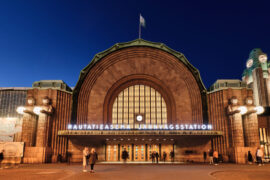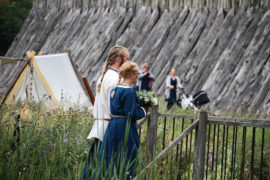Dive with us into the heart of Finnish culture! No, we’re not talking about the sauna or the Moomins – instead, we’re talking about traditional Finnish clothes.
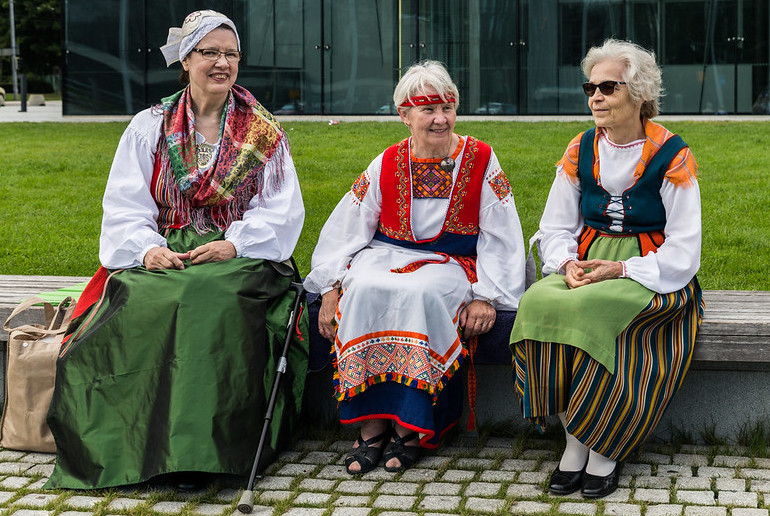
While traditional Finnish clothes are now only worn on special occasions, and by a small subset of the population, they’re an important part of Finland’s history.
Long-standing traditions and important historical events are all woven into the Finnish national dress.
From the detailed Puku dress to the unique Hattu hats, traditional Finnish clothing tells a story – and it can look pretty impressive too, with bright, highly detailed weaves adding a splash of colour to even the greyest of winter days.
Let’s explore Finnish clothing traditions and see how you can try some of these clothes for yourself in Finland.
The roots of Finnish traditional clothing
In ancient Finland, clothing wasn’t merely a sartorial choice; it was an emblem of identity, status and sometimes even a ledger of personal tales.
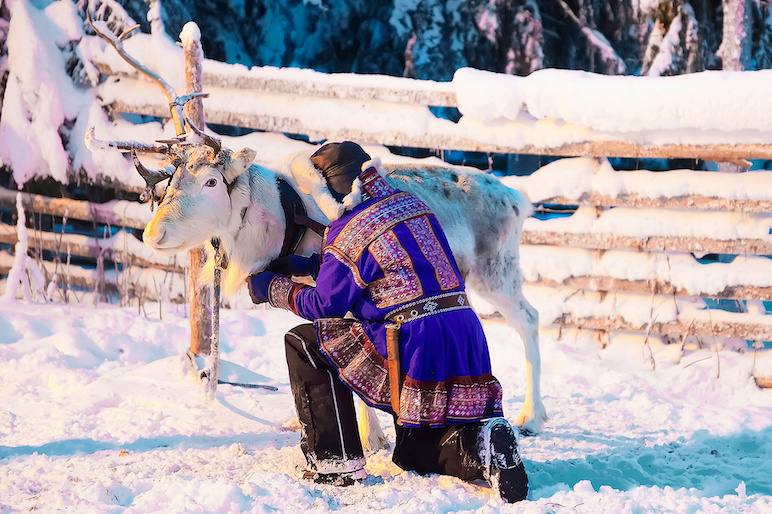
Each stitch, pattern and colour had a purpose, often serving to communicate information about the wearer’s region,marital status or profession.
Finland’s climate can see extreme temperature swings from winter to summer, and the natural elements had a big impact on what people chose to wear throughout the year.
Cold winters demanded the warmth of wool, while short, mild summers introduced breathable linens. Colour choices often mirrored the surrounding nature, embracing the hues of the land, lakes and sky.
Given Finland’s shared borders with Sweden, Norway, and Russia, its clothing also bears hints of these neighboring cultures.
Russian motifs make their way into embroidery, and traditional Scandinavian patterns can also be seen.
Key elements of traditional Finnish clothes
Gákti (Dress/Costume)
The Gákti, a traditional Sami dress, is a vibrant reflection of the indigenous culture of northern Finland. It varies greatly based on the region, with each area boasting distinct colours, patterns and embroidery styles.
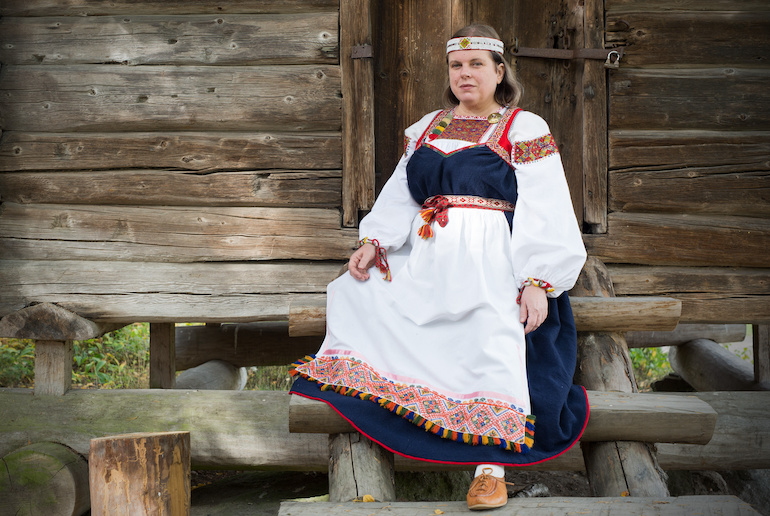
While the Gákti is often worn during special occasions like weddings or festivals, it also serves as a visual representation of the wearer’s family and hometown, telling a personal story through its details.
Nappivyö (Belt)
The Nappivyö, or Vyö for short, is an integral accessory in traditional Finnish dress.
Originally serving a functional purpose, the Vyö has since evolved into a decorative element, with designs and materials varying from region to region.
Hattu (Hat)
The Hattu, a prominent Finnish hat, has a distinctive design for both men and women. Typically fashioned in striking shades of blue and red, these hats are not just traditional symbols but also super cool accessories.
They are paired with the overall ensemble, adding a splash of colour and style to a traditional outfit.
Jalkineet (Footwear)
Reliable Jalkineet, or footwear, is of paramount importance for dealing with the diverse terrains of Finland.
In the snowy north, robust leather boots prevail, while southern regions favour more intricately woven shoes. The styles may differ, but the craftsmanship and practicality remain.
Korut (Jewellery)
Korut, or traditional Finnish jewellery, is an expression of identity, nature and craftsmanship.
Often made from materials such as silver, bone and leather, these pieces reflect the natural environment of Finland and its indigenous Sami population.
Brooches, for instance, are a staple of Finnish dress, often showcasing intricate patterns and designs.
Finnish clothes for special occasions
Traditionally, Finns would wear national dress for special occasions throughout the year. Here are three of the main types of traditional dress, along with an idea of the time of year that they would normally be worn.
Juhannus (Midsummer)
The celebration of Midsummer sees Finns embracing nature in full bloom. Traditional attire is often light and airy, with flower wreaths adorning heads, to symbolize the lushness of the longest day of the year.
Laskiainen (Shrovetide)
Winter’s joyous sledding festival, Laskiainen finds Finns donning warm and colourful outfits. They blend functionality and festivity, with thick fabrics and vibrant patterns that celebrate the joys of snowy descents and wintry fun.
Kansallispuku (other special occasions)
More than just clothing, the Kansallispuku, Finland’s national dress, is a badge of pride. Its designs vary across the regions, with each style narrating tales of local traditions, landscapes and histories.
Evolution over the years
Over time, Finnish fashion has merged traditional and contemporary elements. Today’s Finnish designers often pay homage to the past while introducing fresh interpretations.
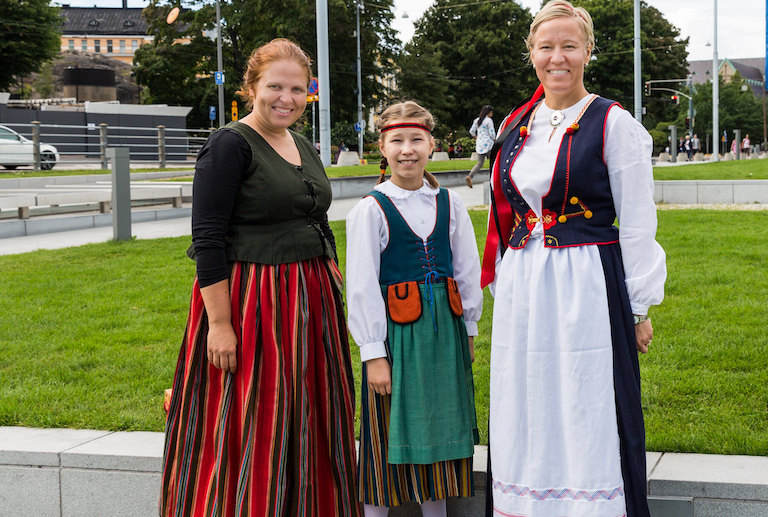
Contemporary fashion in Finland often gives a nod to the past, integrating traditional elements in innovative ways, while ensuring the rich heritage is always present.
Where to try traditional Finnish clothing
If you’re keen to immerse yourself in the world of traditional Finnish attire, here are the best places to start.
Museums
The National Museum of Finland in Helsinki is a treasure trove of ethnic and native costumes and textiles. Here, you can journey through time, witnessing the evolution of Finnish clothing and understanding its cultural significance.
Entrance to the museum is free with the Helsinki Card: for more on whether buying the Helsinki Card can save you money, read our guide.
Festivals
Various events across the country celebrate Finland’s rich heritage, where attendees often don traditional attire. Festivals such as Laskiainen offer a vibrant, hands-on experience, and some may even allow visitors to try on these beautiful garments themselves.
Workshops
For those curious about the craftsmanship behind Finnish clothing, several workshops cater to tourists.
The Craft Museum of Finland in Jyväskylä, for example, runs various workshops where you can learn skills such as traditional embroidery.
These sessions provide insights into the intricate art of creating traditional pieces, ensuring a deeper appreciation of the skill and history involved.
How to try it for yourself
So, perhaps you want to try a Finnish outfit on for yourself? Genuine pieces of traditional clothing are not commonly found in every store, given their deep-rooted cultural significance and unique craftsmanship.
However, there are places where you can rent or buy these precious garments.
Your best bet is to try specialized boutiques or cultural centres in Finnish cities, especially in areas rich with local traditions.
Or, you could have an outfit tailor-made by an artisan tailor. This ensures that the garment not only fits perfectly but also resonates with the authenticity of tradition.
The company Suomi Puku, located in Alajärvi, Finland, sells a diverse range of tailor-made traditional clothing.
Another tip is to contact folk dance groups: they often have connections or recommendations for buying traditional clothing and are usually more than happy to share their love and knowledge of Finnish cultural wear.
However, you should always remember the cultural significance attached to these garments. It’s normally considered okay to wear them, but you should avoid any alterations to their authentic designs.
For those who appreciate a modern touch, contemporary Finnish brands like Aino and Ivana Helsinki seamlessly blend tradition into today’s styles. Ultimately, wearing Finnish clothing isn’t just a fashion statement—it’s a profound embrace of history and culture.
The significance of clothing in Finnish folklore and stories
Finnish folklore brims with tales and legends where clothing plays a prominent role, acting as a symbol of identity, status or even destiny.
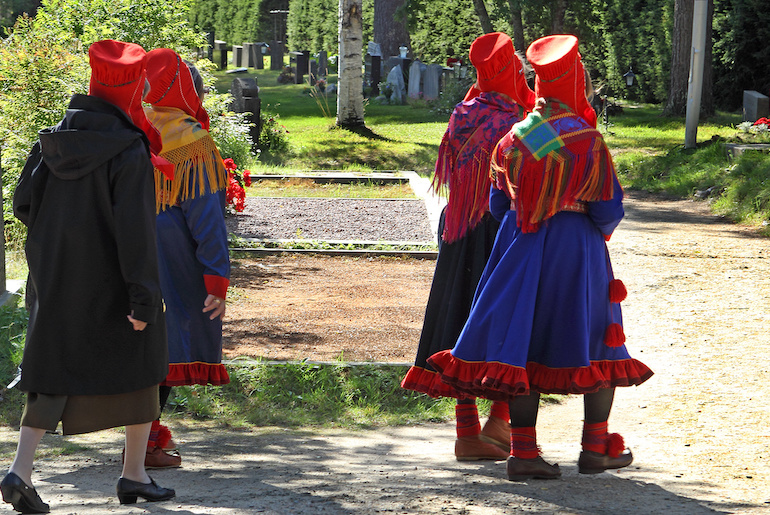
Across various narratives, garments often transcend their basic function, carrying with them tales of honour, love, tragedy and magic.
In some legends, clothing may act as a transformative agent, giving the wearer protection, power, or even a changed identity. In others, clothing might symbolise a rite of passage or a connection to one’s heritage.
Through these tales, we get a glimpse of how the Finns have woven the importance of attire into their cultural storytelling, emphasising its significance beyond mere adornment.
Influence on modern Finnish fashion
Elements from historical designs, like intricate embroidery or specific patterns, often find their way into contemporary styles.
Renowned designers such as Maija Isola have drawn inspiration from age-old motifs, transforming them into contemporary prints.
Brands like Aino and Ivana Helsinki continue this trend, blending traditional design features into modern attire.
The mix of old and new serves as a testament to Finland’s respect for tradition, even as it strides confidently into the future of fashion.
See also:
Scandinavian folk art and where to see it
All you need to know about Norwegian Rosemaling
Moomin attractions in Finland



